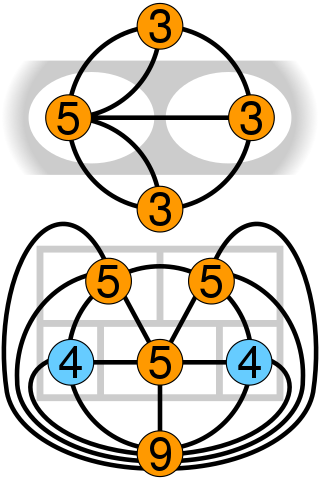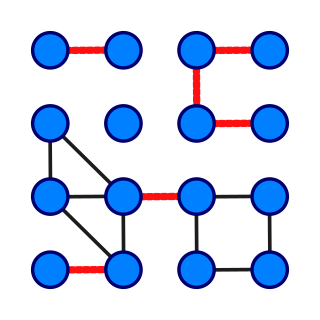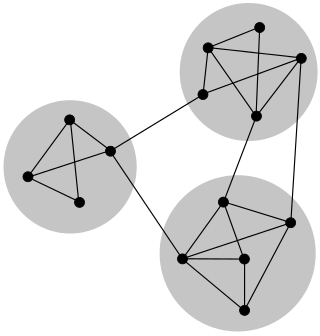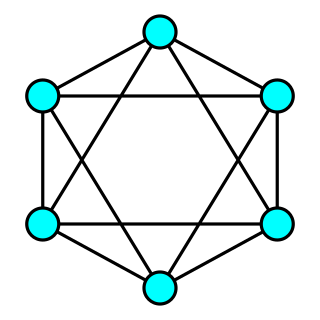The Query and Insert operations are implemented using the corresponding operations on the ET trees representing F. The challenging operation is Delete, and in particular, deleting an edge which is contained in one of the spanning trees of F. This breaks the spanning tree into two trees, but, it is possible that there is another edge which connects them. The challenge is to quickly find such a replacement edge, if it exists. This requires a more complex data structure. Several such structures are described below.
The Level structure
Each edge in the graph is assigned a level. Let L=lg n. The level of each edge inserted to the graph is initialized to L, and may decrease towards 0 during delete operations.
For each i between 0 and L, define Gi as the subgraph consisting of edges that are at level i or less, and Fi a spanning forest of Gi. Our forest F from before is now called FL. We will keep a decreasing sequence of forests FL ⊇ ... ⊇ F0. [5] [6]
Operations
The Query and Insert operations use only the largest forest FL. The smaller subgraphs are consulted only during a Delete operation, and in particular, deleting an edge which is contained in one of the spanning trees of FL.
When such an edge e = x−y is deleted, it is first removed from FL and from all smaller spanning forests to which it belongs, i.e. from every Fi with i ≥ level(e). Then we look for a replacement edge.
Start with the smallest spanning forest which contained e, namely, Fi with i = level(e). The edge e belongs to a certain tree T⊆Fi. After the deletion of e, the tree T is broken to two smaller trees: Tx which contains the node x and Ty which contains the node y. An edge of Gi is a replacement edge, if and only if it connects a node in Tx with a node in Ty. Suppose wlog that Tx is the smaller tree (i.e. contains at most half the nodes of T; we can tell the size of each subtree by an annotation added to the Euler trees).
We first decrease the level of each edge of Tx by 1. Then we loop over all the edges ε with level i and at least one node in Tx:
- If the other node of ε is in Ty, then a replacement edge is found! Add this edge to Fi and to all containing forests up to FL, and finish. The spanning forests are fixed. Notice that in order to pay for this search, we decrease the level of the edges visited during the search.
- If the other node of ε is in Tx, then this is not a replacement edge, and to 'penalize' it for wasting our time, we decrease its level by 1.
Analysis
The level of each edge will be decreased at most lg n times. Why? Because with each decrease, it falls into a tree whose size is at most half the size of its tree in the previous level. So in each level i, the number of nodes in each connected component is at most 2i. Hence the level of an edge is always at least 0.
Each edge whose level is decreased, takes  time to find (using the ET tree operations). In total, each inserted edge takes
time to find (using the ET tree operations). In total, each inserted edge takes  time until it is deleted, so the amortized time for deletion is
time until it is deleted, so the amortized time for deletion is  . The remaining part of delete also takes
. The remaining part of delete also takes  time, since we have to delete the edge from at most
time, since we have to delete the edge from at most  levels, and deleting from each level takes
levels, and deleting from each level takes  (again using the ET operations).
(again using the ET operations).
In total, the amortized time per update is  . The time per query can be improved to
. The time per query can be improved to  .
.
However, the worst-case time per update might be  . The question of whether the worst-case time can be improved had been an open question, until it was solved in the affirmative by the Cutset structure.
. The question of whether the worst-case time can be improved had been an open question, until it was solved in the affirmative by the Cutset structure.
The Cutset structure
Given a graph G(V,E) and a subset T⊆V, define cutset(T) as the set of edges that connect T with V\T. The cutset structure is a data structure that, without keeping the entire graph in memory, can quickly find an edge in the cutset, if such an edge exists. [7]
Start by giving a number to each vertex. Suppose there are n vertices; then each vertex can be represented by a number with lg(n) bits. Next, give a number to each edge, which is a concatenation of the numbers of its vertices - a number with 2 lg(n) bits.
For each vertex v, calculate and keep xor(v), which is the xor of the numbers of all edges adjacent to it.
Now for each subset T⊆V, it is possible to calculate xor(T) = the xor of the values of all vertices in T. Consider an edge e = u−v which is an internal edge of T (i.e. both u and v are in T). The number of e is included twice in xor(T) - once for u and once for v. Since the xor of every number with itself is 0, e vanishes and does not affect xor(T). Thus, xor(T) is actually the xor of all edges in cutset(T). There are several options:
- If xor(T)=0, then we can confidently reply that cutset(T) is empty.
- If xor(T) is the number of a real edge e, then probably e is the only edge in cutset(T), and we can return e. We can also read the endpoints of e from the number of e by splitting it to the lg(n) leftmost bits and the lg(n) rightmost bits.
- The third option is that xor(T) is a nonzero number which does not represent a real edge. This can only happen if there are two or more edges in cutset(T), since in that case xor(T) is the xor of several numbers of edges. In this case, we report "failure", since we know that there are edges in the cutset but cannot identify any single edge. [8]
Our goal now is to handle this third option.
First, create a sequence of lg(n) levels of the cutset structures, each of which contains about half the edges from the upper level (i.e., for each level, pick each edge from the upper level with probability 1/2). If in the first level xor(T) returns an illegal value, meaning that cutset(T) has two or more edges, then there is a chance that in the next level, which contains fewer edges, xor(T) will return a legal value since cutset(T) will contain a single edge. If xor(T) still returns an illegal value, continue to the next level, etc. Since the number of edges is decreasing, there are two cases:
- The good case is that we eventually find a level in which cutset(T) contains a single edge; then we return that edge and finish.
- The bad case is that we eventually find a level in which cutset(T) contains no edges; then we report "failure", since we know that there are edges in the cutset but cannot identify any single edge.
It is possible to prove that the probability of success is at least 1/9.
Next, create a collection of C lg(n) independent versions of the level structure, where C is a constant. In each versions, do an independent random reduction of edges from level to level. Try each query on each of the versions until one of them succeeds. The probability that all versions fail is at most:

By proper selection of C we can make the probability of failure arbitrarily close to 0.
Operations
We can add a cutset structure to a dynamic connectivity structure.
The Insert and Delete operations on the cutset structure are done in exactly the same way: the edge inserted/deleted is XORed into both its endpoints.
When an edge is deleted from the spanning forest used for the dynamic connectivity structure, the cutset structure is used to find a replacement edge.
Analysis
A single cutset structure requires only O(n lg n) memory - only a single number, with 2 lg n bits, for each of the n vertices. We don't have to keep the edges themselves. For dense graphs, this is much cheaper than keeping the entire graph in memory.
We have to keep lg(n) versions, each of which contains lg(n) levels. Hence, the total memory requirement is  .
.
The query time is O(polylog(n)) in the worst case. This is in contrast to The Level structure, in which the query time is O(polylog(n)) amortized, but the worst-case time is O(n).

























